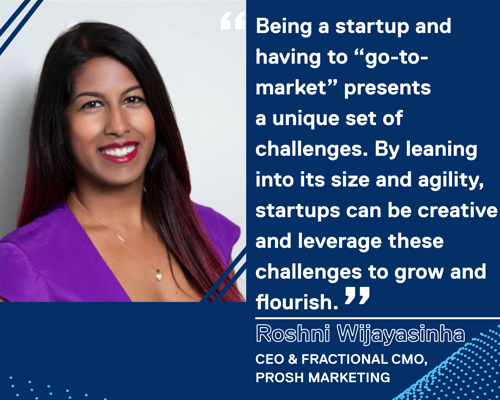4 Important Marketing Tips for Startups
- Roshni Wijayasinha, CEO & Fractional CMO at Prosh Marketing (external link)

Being a startup and having to “go-to-market” presents a unique set of challenges:
- a lean budget
- lack of brand awareness
- the lack of historical marketing data to make decisions
- the need to produce results quickly
Having worked with a number of early-stage startups to build their marketing teams, plans and programs, I’ve noticed some strategies are especially effective in overcoming these challenges. Here are some of my top tips:
1. Strategically leverage your resources.
Startups may not have the luxury of large marketing teams but that doesn’t mean they can’t accomplish a lot. Leveraging the help of your network can be a first step to punch above your weight.
For example, Advisors can help open doors and provide great strategic direction, Investors often have PR groups that can help you spread your message, and Partners or vendors can have communication channels that you may also be able to tap into.
There are also many partners that can help you implement your marketing efforts more efficiently than hiring a large internal team. For example, freelancers or small agencies can help supplement a small team with specialized skills that an internal project coordinator can manage. A new Fractional CMO model has also emerged, allowing startups to access a senior marketing leader and their expertise part time, and therefore at a fraction of the cost of a full-time salary.
2. Don’t just focus on the bottom of the funnel.
Being a new company means it is of utmost importance to build brand and product awareness. As a startup, you’ll need to develop an audience of people interested in your product before you can actually sell to them, which means the top of the funnel should be one of your main priorities.
It can be tempting to spend your budget on the bottom of the funnel where there is higher intent and returns are predictable but this can be expensive and short sighted. Not only are lower funnel channels generally more expensive but without continually filling your funnel with new prospects, you'll face rising costs trying to convert a smaller pool of people who have not yet converted for some reason or another.
“Many marketers have found that incorporating both brand building and performance elements in a campaign often increases the overall return on ad spend compared with spending on performance channels alone,” according to a recent McKinsey article, “Why every business needs a full funnel marketing strategy”.
The need for quick returns should not divert you from carving out a portion of your budget for brand marketing and awareness building activities at the same time.
3. Don’t skimp on customer research.
It can be tempting to think that you know the target audience, even if you are part of it. However, talking to customers can give you a different perspective and even help you discover things you may have overlooked. If you have a limited budget, you’ll want to spend it wisely so having an informed point of view can help you make better marketing decisions (and other ones too!).
Customer research can be very insightful and doesn’t have to cost a ton. There are many resources at your disposal including having staff perform customer intercept interviews at point of sale, calling up repeat customers and inviting them to a focus group and leveraging technologies like userinterviews.com and pollfish.com. Receiving information from your customers or target audience can indeed be done on a budget.
Imagine finding out what 100 people in your target audience rank the most important when purchasing something in your category, or what price they would pay for your services or where they learn about products like yours. This kind of information can be invaluable when crafting your marketing strategies and plans.
4. A/B Test.
Given the fact that you are marketing to your target audience for the first time, there will be a lot of learning to do. What channels most efficiently reach your target market? Which messages best resonate with customers? Which call to actions are most likely to convert? It is advisable to create small tests with small budgets and then use the results to inform larger campaigns.
Startups that use A/B testing scale more quickly, launch more products, and attract more venture capital, according to recent research,” states Kristen Senz in their article on A/B testing published on Harvard Business School’s Working Knowledge – Research and Ideas Section.
A simple A/B test involves testing 1 variable and holding everything else in a control or constant state. It can seem appealing to try to test a variety of items at once to save time but it becomes difficult to attribute the results to different variables, especially when so many of them are changing.
The challenges a startup faces should also be seen as opportunities to be more efficient and to get closer to customers. Large companies’ established and well funded marketing programs can seem enviable but their structure causes other issues - their large budgets can tempt them to overspend, their existing brand awareness can be taken for granted though it must be continuously maintained, and their knowledge of their customers which can shift quickly as customer preferences do. By leaning into its size and agility, startups can be creative and leverage these challenges to grow and flourish.